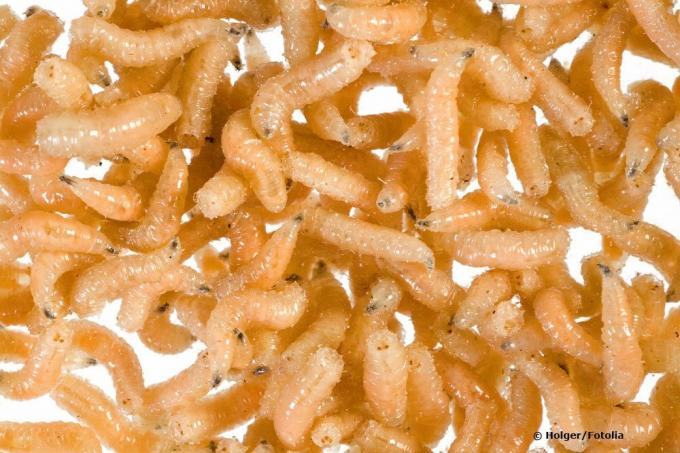
table of contents
- Locate the fly's nest
- Signs of egg laying
- Fight the fly's nest
- Prevent instead of eliminating
- frequently asked Questions
Flies are a nuisance. In order to get rid of the pests permanently, you should tackle the problem at the root. Don't just drive away the individual animals, but fight the fly's nest.
In a nutshell
- a real fly's nest does not exist
- Flies usually lay their eggs directly in a food supply
- avoid potential breeding grounds instead of fighting the clutches later
Locate the fly's nest
Removing fly nests is particularly difficult. Because although the title may suggest this, flies do not build a real nest. Although they put large quantities of eggs together in one place, they do not build a real dwelling, as you are probably familiar with from birds, bees or rodents. Rather, the environment must have favorable living conditions so that the hatching larvae have a high probability of developing into adult flies themselves. This requires warmth and darkness on the one hand, but primarily a good source of food on the other. In many cases, the fly then lays its eggs directly into this food source, so that the The offspring are taken care of immediately and start eating and growing immediately after hatching can begin. The following things are very attractive to the fly as a source of food and nutrients:

- Leftovers
- Fruit, especially when fully ripe or already rotting
- Biowaste
- Juices, sodas, or other sugary drinks
- Feces, especially feces
- Carrion
Due to their tiny size and the hidden deposit in the food sources already mentioned, you will never be able to find the clutch yourself under normal circumstances.
Note: In their roughly three-week life, flies lay eggs five to six times. In total, up to 1,000 eggs from a single mother can lay the basis for the next generation.
Signs of egg laying
Instead of looking for the non-existent fly's nest, you should keep your eyes open and watch out for signs of possible clutches. You can recognize them by the small, whitish-yellow maggots. If you discover several of these animals, for example on the ground, you can assume that there is a fly nest nearby. From there, in the course of their development, the maggots often go in search of new sources of food and appear clearly visible to you.
We assume that you do not keep leftover food or even faeces open, but remove it early on. Therefore
The occurrence of fly larvae means that a comparable breeding site must be available in another, invisible place. Typical places for this are:

- Under kitchen components
- Behind cupboards
- In cracks in the floor or wall
- Behind skirting boards
- Behind things stored on shelves, cupboards, and other dark areas
- Other comparable areas
Fight the fly's nest
Now the big question is how to proceed after noticing the signs of a fly nest. First of all, one thing is important here: You must remove the fly's nest or find its basis in the form of leftover food or dead animals. Orientate yourself on the found maggots and possible cracks and joints from which they may have come. Once you have found the breeding site, remove whatever basic food you find there with the following measures:
- Eliminate any residue from food, feces or carcasses
- Remove all maggots found
- thorough cleaning with soap, washing-up liquid or universal cleaner
- Extensive subsequent cleaning with vinegar water or soapy water to remove any remaining traces of scent
Tip: Avoid simply "flooding" areas that are not visible with insecticides. On the one hand, there is a high probability that you will not reach all animals in this way. Above all, the basis for the breeding ground remains intact, so that sooner or later you will have to reckon with more generations of flies!
Prevent instead of eliminating
You should, precisely because it is often very difficult to find and remove a fly's nest Instead, make sure that flies have no potential places to lay their eggs in the first place find. You can achieve this with just a few simple adjustments to your behavior:

- Dispose of leftover food immediately
- Do not store organic waste in the rubbish bin, but remove it from the apartment immediately
- Remove residue after cooking or eating, and wipe areas
- do not leave half-full glasses
- Consume or cover ripe fruit
- Pack diaper rubbish airtight and dispose of it quickly
- Close open cracks and joints as far as possible in order to prevent animals from entering and perishing
You can also prevent flies from being a potential starting point for future generations by taking the following measures:
- Prevent access through mosquito nets
- defensive scented plants, such as. B. peppermint, basil, Geraniums, lemon balm etc. place in front of windows and patio doors
- Fly traps, e.g. B. set up as glue traps or sugar traps
frequently asked Questions
First of all, get rid of the symptoms, i.e. the maggots. There is a possibility that the food supply was so low that no further eggs are laid. Most of the time, however, you can hardly avoid the further search, since even small insects or small food residues are a warm invitation for numerous flies.
Ultimately, it is up to you whether you take up the fight against the fly nests. However, the animals are able to transmit germs and pathogens. Therefore, you should be keen to get a handle on excessive multiplication.
Of course, the use of the fly swatter also leads to the hoped-for success - provided you are accurate. However, you should remove the killed animals and clean the affected area with vinegar water. Because the crushed animals transfer possible germs and pathogens to the surface of the table, wall or other location of the fly.

